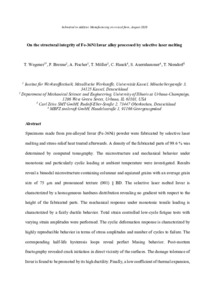| dc.date.accessioned | 2023-12-22T13:23:59Z | |
| dc.date.available | 2023-12-22T13:23:59Z | |
| dc.date.issued | 2020 | |
| dc.identifier | doi:10.17170/kobra-202311309142 | |
| dc.identifier.uri | http://hdl.handle.net/123456789/15325 | |
| dc.description | © This manuscript version is made available under the CC-BY-NC-ND 4.0 license https://creativecommons.org/licenses/by-nc-nd/4.0/ | eng |
| dc.language.iso | eng | |
| dc.rights | Attribution-NonCommercial-NoDerivatives 4.0 International | * |
| dc.rights.uri | http://creativecommons.org/licenses/by-nc-nd/4.0/ | * |
| dc.subject | Invar 36 | eng |
| dc.subject | additive manufacturing | eng |
| dc.subject | selective laser melting | eng |
| dc.subject | low-cycle fatique | eng |
| dc.subject | microstructure | eng |
| dc.subject.ddc | 600 | |
| dc.subject.ddc | 660 | |
| dc.title | On the structural integrity of Fe-36Ni Invar alloy processed by selective laser melting | eng |
| dc.type | Aufsatz | |
| dcterms.abstract | Specimens made from pre-alloyed Invar (Fe-36Ni) powder were fabricated by selective laser melting and stress-relief heat treated afterwards. A relative density of the fabricated parts of 99.6 % was determined by computed tomography. The microstructure and mechanical behavior under monotonic and particularly cyclic loading at ambient temperature were investigated. Results reveal a bimodal microstructure containing columnar and equiaxed grains with an average grain size of 75 μm and pronounced texture 〈001〉 || BD. The selective laser melted Invar is characterized by a homogeneous hardness distribution revealing no gradient with respect to the height of the fabricated parts. The mechanical response under monotonic tensile loading is characterized by a fairly ductile behavior. Total strain controlled low-cycle fatigue tests with varying strain amplitudes were performed. The cyclic deformation response is characterized by highly reproducible behavior in terms of stress amplitudes and number of cycles to failure. The corresponding half-life hysteresis loops reveal perfect Masing behavior. Post-mortem fractography revealed crack initiation in direct vicinity of the surfaces. The damage tolerance of Invar is found to be promoted by its high ductility. Finally, a low coefficient of thermal expansion, very similar to conventionally processed Invar, was shown by dilatometer tests in the temperature range of 0 °C–180 °C. | eng |
| dcterms.accessRights | open access | |
| dcterms.creator | Wegener, Thomas | |
| dcterms.creator | Brenne, Florian | |
| dcterms.creator | Fischer, Andreas | |
| dcterms.creator | Möller, Timo | |
| dcterms.creator | Hauck, Christoph | |
| dcterms.creator | Auernhammer, Stefan | |
| dcterms.creator | Niendorf, Thomas | |
| dc.relation.doi | doi:10.1016/j.addma.2020.101603 | |
| dc.subject.swd | Invar-Legierung | ger |
| dc.subject.swd | Rapid Prototyping <Fertigung> | ger |
| dc.subject.swd | Selektives Laserschmelzen | ger |
| dc.subject.swd | Ermüdung bei niedrigen Lastspielzahlen | ger |
| dc.subject.swd | Mikrostruktur | ger |
| dc.subject.swd | Mechanische Eigenschaft | ger |
| dc.type.version | acceptedVersion | |
| dcterms.source.identifier | eissn:2214-7810 | |
| dcterms.source.journal | Additive Manufacturing | eng |
| dcterms.source.volume | Volume 37 | |
| kup.iskup | false | |
| dcterms.source.articlenumber | 101603 | |


